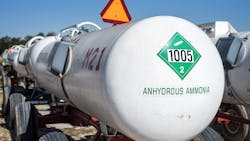A new study finds that removing ammonia from wastewater and converting it into fertilizer could help reduce the footprint of fertilizer production and bring a new revenue stream for water treatment facilities, according to Drexel University.
The study explored the feasibility of an ammonium sulfate recovery process known as air-stripping. It found that the process may be significantly more sustainable than the current mainstream ammonia production process, presenting a unique opportunity for wastewater treatment facilities.
A Sustainable Nitrogen Source
The production of nitrogen for fertilizer is an energy-intensive process and accounts for nearly 2 percent of global carbon dioxide emissions. In the last several years researchers have explored alternatives to the Haber-Bosch nitrogen production process, which has been the standard for more than a century. One promising possibility, recently raised by some water utility providers, is gleaning nitrogen from the waste ammonia pulled from water during treatment.
“Recovering nitrogen from wastewater would be a desirable alternative to the Haber-Bosch process because it creates a ‘circular nitrogen economy,’” says Patrick Gurian a professor in Drexel's College of Engineering who helped lead the research. “This means we are reusing existing nitrogen rather than expending energy and generating greenhouse gas to harvest nitrogen from the atmosphere, which is a more sustainable practice for agriculture and could become a source of revenue for utilities.”
A Cleaner Way to Clean
Under the Clean Water Act of 1972 municipal water treatment facilities have been challenged to meet water quality standards for water that they discharge into waterways. Increasingly, ammonia is seen as both a concern for aquatic environments, as elevated levels of ammonia can result in overgrowth of vegetation in streams, and rivers which can endanger fish species. The options for removing ammonia are generally time and space consuming and can be energy-intensive undertakings.
One option being explored by several facilities in North America and Europe is a process called air-stripping. It removes ammonia by raising the temperature and pH of the water enough to convert the chemical into a gas, which can then be collected in concentrated form as ammonium sulfate.
But deciding on making the investment to convert to air-stripping requires a complex study of its technological and financial viability, called a lifecycle analysis.
Exploring the Option
The team, led by Gurian and Sabrina Spatari from Technion Israel Institute of Technology, regularly perform these analyzes to take stock of the full environmental and economic impact of various options for recycling and reuse of waste or side-stream products as sustainable solutions.
Their analysis of this wastewater scenario suggests there is a complementary relationship that could result in a more sustainable path for both farmers and water management authorities. The latest study was published in the journal Science of the Total Environment.
Using data from Philadelphia’s water treatment facility and several others across North America and Europe, the team conducted lifecycle assessment and economic feasibility studies. They looked at factors ranging from the cost of installing and maintaining an air-stripping system, to the concentration of ammonia and flow rate of the wastewater, to the sources of energy used to drive the collection and conversion process, to the production and transportation cost and market price of the fertilizer chemicals.
Promising Results
Findings of the life-cycle analysis show that air-stripping emits about five to 10 times less greenhouse gas than the Haber-Bosch nitrogen-producing process and uses about five to 15 times less energy.
From an economic perspective, the overall cost of producing fertilizer chemicals from wastewater is low enough that the producer could sell them at a price more than 12 times lower than Haber-Bosch-produced chemicals and still break even.
In addition, the study suggests that water treatment facilities may enjoy energy savings by air-stripping the ammonia to reduce levels before the water it reenters the waste treatment process. This is because it would cut the time and processing needed to treat the water and fits in well with softening processes that help to slow chemical deposition on the treatment plant infrastructure.
While the team acknowledges that air-stripping would churn out fertilizer in smaller amounts than the industrial Haber-Bosch process, being able to collect and reuse any quantity of resources helps to improve the sustainability of commercial agriculture and prevents them from becoming water pollutants.
“This indicates that air-stripping for recovery of ammonium sulfate could be a small part – but an important step – toward recovering and reusing the massive amount of nitrogen we use to sustain global agriculture,” Spatari says. “And, significantly it presents an alternative for chemical production that does not have the same level of deleterious environmental and human health effects as the current process. This research suggests that water utility providers could also consider investing in technologies that would capture phosphorus and recycle it for agricultural use.”



